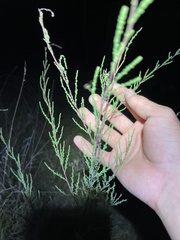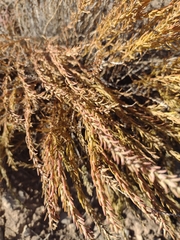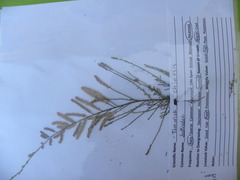Tamarix chinensis: taxon details and analytics
- Domain
- Kingdom
- Plantae
- Phylum
- Tracheophyta
- Class
- Magnoliopsida
- Order
- Caryophyllales
- Family
- Tamaricaceae
- Genus
- Tamarix
- Species
- Tamarix chinensis
- Scientific Name
- Tamarix chinensis
Summary description from Wikipedia:
Tamarix chinensis
Tamarix chinensis is a species of tamarisk known by the common names five-stamen tamarisk and Chinese tamarisk or saltcedar. It is native to China and Korea, and it is known in many other parts of the world as an introduced species and sometimes an invasive noxious weed. It easily inhabits moist habitat with saline soils. It may grow as a tree with a single trunk or as a shrub with several spreading erect branches reaching 6 metres or more in maximum height. It has been known to reach 12 metres. It has reddish, brown, or black bark. The small, multibranched twigs are covered in small lance-shaped, scale-like leaves which are no more than about 3 mm long. The inflorescence is a dense raceme of flowers a few cm long. Each fragrant flower has five petals which are usually pink but range from white to red.
This tamarisk can hybridize with Tamarix parviflora. T. ramosissima may be treated in synonymy or as a separate species.
It has become an aggressive invader of wildlands in the southwestern United States, where it was once planted as an ornamental plant. It reproduces vegetatively from its roots and also from its foliage if it happens to be covered by soil, as in sediment-rich flooding. It also reproduces by its seed, which are tiny and tufted with hairs, easily dispersing on the wind. Despite its reputation as a noxious weed, the tree can be useful for wood, in honey production, and as a nesting site for various birds.
In its native habitat in China the plant forms thickets that act as useful barriers on the margins of waterways, including saline ocean shores.
...Tamarix chinensis in languages:
- Afrikaans
- Chinese Tamarisk
- Arabic
- طرفاء خماسية السداة
- Arabic
- طرفاء صينية
- Chinese
- 華北檉柳
- Chinese
- 檉柳
- Czech
- tamaryšek čínský
- Danish
- kinesisk tamarisk
- English
- Five-stamen Tamarisk
- English
- Chinese Tamarisk
- English
- Chinese Saltcedar
- German
- Chinesische Tamariske
- Hebrew
- אשל סין
- Italian
- Tamerice cinese
- Japanese
- ギョリュウ
- Japanese
- サツキギョリュウ
- Russian
- Гребенщик китайский
- Swedish
- kinesisk tamarisk
Images from inaturalist.org observations:
We recommend you sign up for this excellent, free service.
Parent Taxon
Sibling Taxa
- Tamarix africana
- Tamarix alii
- Tamarix amplexicaulis
- Tamarix androssowii
- Tamarix aphylla
- Tamarix aralensis
- Tamarix arborea
- Tamarix arceuthoides
- Tamarix aucheriana
- Tamarix austromongolica
- Tamarix baluchistanica
- Tamarix boveana
- Tamarix brachystachys
- Tamarix canariensis
- Tamarix chinensis
- Tamarix dalmatica
- Tamarix dioica
- Tamarix dubia
- Tamarix duezenlii
- Tamarix elongata
- Tamarix ericoides
- Tamarix florida
- Tamarix gallica
- Tamarix gansuensis
- Tamarix gennessarensis
- Tamarix gracilis
- Tamarix hampeana
- Tamarix hispida
- Tamarix hohenackeri
- Tamarix humboldtiana
- Tamarix indica
- Tamarix jintaensis
- Tamarix jordanis
- Tamarix karelinii
- Tamarix kasahorum
- Tamarix kermanensis
- Tamarix komarovii
- Tamarix korolkowii
- Tamarix kotschyi
- Tamarix kutchensis
- Tamarix laxa
- Tamarix leptostachya
- Tamarix litwinowii
- Tamarix macrocarpa
- Tamarix mascatensis
- Tamarix meyeri
- Tamarix minoa
- Tamarix mongolica
- Tamarix negevensis
- Tamarix nilotica
- Tamarix octandra
- Tamarix pakistanica
- Tamarix palaestina
- Tamarix parviflora
- Tamarix passerinoides
- Tamarix pycnocarpa
- Tamarix ramosissima
- Tamarix rosea
- Tamarix sachensis
- Tamarix salina
- Tamarix sarenensis
- Tamarix senegalensis
- Tamarix smyrnensis
- Tamarix stricta
- Tamarix sultanii
- Tamarix szovitsiana
- Tamarix taklamakanensis
- Tamarix tarimensis
- Tamarix tetragyna
- Tamarix tetrandra
- Tamarix usneoides































































































































































